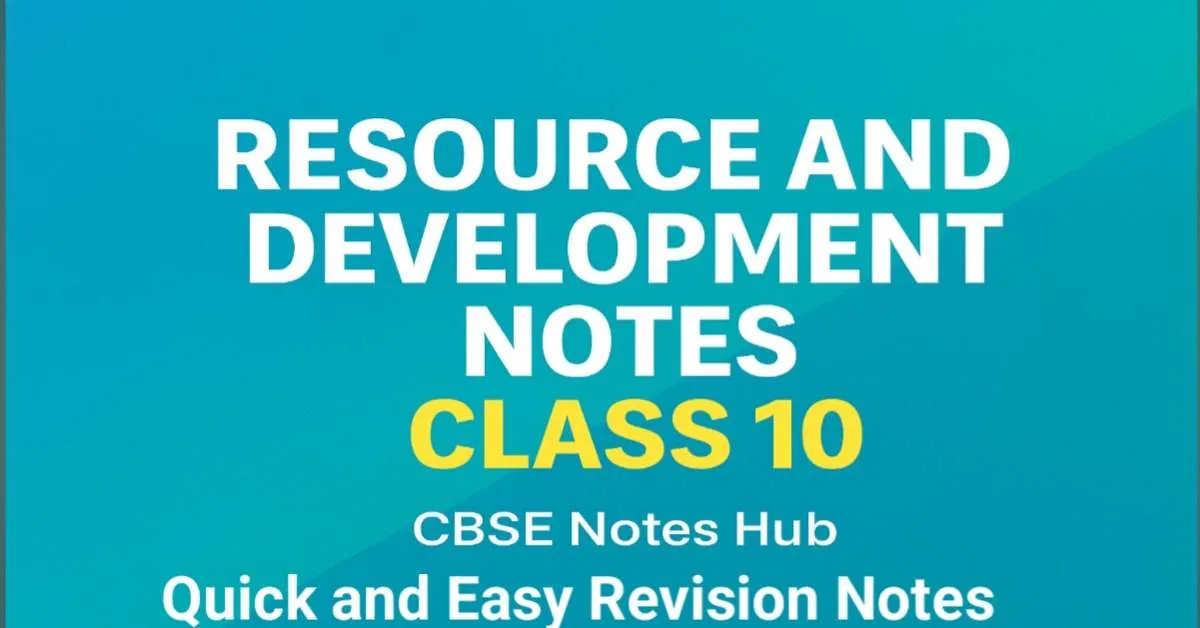This post explains what can be termed as a resource, classification of resources, First Earth Summit, diversity in availability of resources in India, and problems associated with indiscriminate use of resources.
Resources and Development – Class 10 Geography Notes (Part 1)
Resource
- Everything available in our environment that can be used to satisfy our needs, provided it is technologically accessible, economically feasible, and culturally acceptable.
- Resources are the result of human interaction with nature.
- Human beings interact with nature through technology and create institutions to accelerate economic development.
Human Interaction with Nature
- Human beings ↔ Physical environment (Nature) ↔ Technology ↔ Institutions
Resources are not free gifts of nature.
Classification of Resources
- On the basis of origin – Biotic and Abiotic
- On the basis of exhaustibility – Renewable and Non-renewable
- On the basis of ownership – Individual, Community, National, and International
- On the basis of status of development – Potential, Developed, Stock, and Reserves
Development of Resources
- Resources are essential for human survival and for maintaining the quality of life.
- Indiscriminate use of resources leads to problems such as:
- Depletion of resources for satisfying the greed of a few individuals.
- Accumulation of resources in the hands of a few — creating divisions between the rich and poor.
- Environmental degradation leading to:
- Global Warming
- Ozone Layer Depletion
- Pollution
- Land Degradation
An equitable distribution of resources is essential for sustained quality of life.
There is a need for resource planning.
Sustainable Development
- Development should take place without damaging the environment.
- It should meet the needs of the present without compromising the needs of future generations.
📘 Must Read:
📌 Development – Class 10 Notes
Rio de Janeiro Earth Summit (1992)
- First Earth Summit attended by more than 100 heads of state.
- Held at Rio de Janeiro, Brazil.
- Focused on environmental protection and socio-economic development at the global level.
- Leaders signed the Declaration on Global Climate Change and Biological Diversity.
Outcomes of Earth Summit
- Endorsed the global forest principles.
- Adopted Agenda 21 for sustainable development.
UNCED (United Nations Conference on Environment and Development)
- Aims of Agenda 21:
- To achieve sustainable development.
- To combat environmental damage, poverty, and diseases through global cooperation.
- Each local government should draw its own local Agenda 21.
Resource Planning
- Widely accepted strategy for judicious use of resources.
- India has great diversity in the availability of resources.
Importance of Resource Planning in India
- Jharkhand, Chhattisgarh, Madhya Pradesh – Rich in minerals and coal deposits.
- Arunachal Pradesh – Rich in water resources but poor in infrastructure.
- Rajasthan – Rich in wind and solar energy but lacks water resources.
- Ladakh – Rich cultural heritage but deficient in water, infrastructure, and vital minerals.
Hence, resource planning is necessary at national, state, regional, and local levels.
Steps in Resource Planning (India)
- Identification and inventory of resources across regions through survey and mapping.
- Developing a planning structure with suitable technology, skills, and institutions.
- Matching resource development plans with overall national development plans.
- India has worked on resource planning since the First Five-Year Plan.
- Availability of resources alone is not sufficient; technology and institutional support are equally essential.
- Resource development involves technology, human resources, and historical experience.
Source: NCERT
📘 Also Read:
📌
Power Sharing in Belgium and Sri Lanka – Class 10
📌
Class 10 History Chapter 1 Important Questions – CBSE 2026

